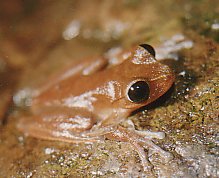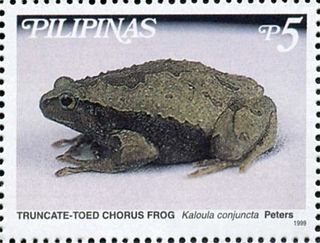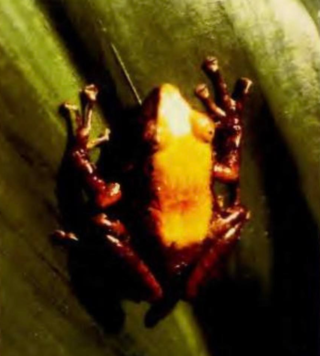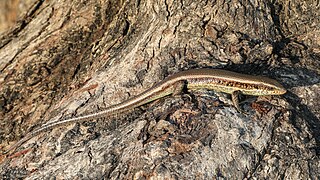
Mount Banahaw is an active complex volcano on Luzon in the Philippines. The three-peaked volcano is located at the boundary of Laguna and Quezon provinces. It is the highest mountain in both provinces and Calabarzon region, dominating the landscape for miles around.

Nyctimystes is a genus of tree frogs in the subfamily Pelodryadinae of the family Hylidae. They are principally Papuan species, but also inhabit islands in the Moluccas. All species in this genus have one distinct feature that separates them from other species in the family, the lower eyelid is marked with pattern of lines, veins, or dots. This feature presumably acts as camouflage when the frogs are at rest during the day.

Xenorhina is a genus of microhylid frogs. The genus is endemic to New Guinea. They are sometimes known as the snouted frogs or fanged frogs, the latter referring to the now-synonymized genus Xenobatrachus.

The Philippine narrowmouth toad or the truncate-toed chorus frog is a species of frog in the family Microhylidae. It is endemic to the Philippines. Its natural habitats are subtropical or tropical dry forests, subtropical or tropical moist lowland forests, subtropical or tropical moist shrubland, subtropical or tropical seasonally wet or flooded lowland grassland, rivers, intermittent rivers, freshwater lakes, intermittent freshwater lakes, freshwater marshes, intermittent freshwater marshes, arable land, pastureland, plantations, rural gardens, heavily degraded former forest, water storage areas, ponds, irrigated land, and seasonally flooded agricultural land. It is threatened by habitat loss.
Kaloula walteri is a species of frog in the family Microhylidae. It is endemic to the Philippines, where it is found in the mountains of southeastern Luzon Island and Polillo Island. The specific name walteri honors Walter C. Brown, an American herpetologist. Common name Walter's narrow-mouthed frog has been proposed for it. Kaloula walteri is most closely related to Kaloula rigida.

The Banahao forest frog is a species of frog in the family Ceratobatrachidae. It is endemic to Luzon, Philippines, where it is only known from Mount Banahaw.
Cornufer cheesmanae is a species of frog in the family Ceratobatrachidae. It is endemic to New Guinea and found in the Cyclops Mountains and Bewani Mountains. The specific name cheesmanae honors Lucy Evelyn Cheesman, an English entomologist, explorer, and curator at London Zoo. Common name Cheesman's wrinkled ground frog has been coined for it.
Cornufer gilliardi, commonly known as Gilliard's wrinkled ground frog, is a species of frog in the family Ceratobatrachidae. It is endemic to the Whiteman Ranges of New Britain, Bismarck Archipelago. The specific name gilliardi honors Ernest Thomas Gilliard, an American ornithologist who, together with Margaret Gilliard, collected the holotype.
Platymantis isarog, sometimes known as the Isarog forest frog, is a species of frog in the family Ceratobatrachidae. It is endemic to southeastern Luzon, Philippines, where it is known from two volcanos, Mount Isarog and Mount Malinao.
Cornufer macrosceles is a species of frog in the family Ceratobatrachidae. It is endemic to the island of New Britain, Papua New Guinea. It is only known from the Nakanai Mountains in the central part of the island. Only three specimens are known. Common name Ti wrinkled ground frog has been coined for the species.
Platymantis montanus is a species of frog in the family Ceratobatrachidae. It is endemic to southwestern Luzon, the Philippines, and is known from its type locality, Mount Banahaw, and from Mount Apoy.
Cornufer schmidti is a species of frog in the family Ceratobatrachidae. It was first described as a subspecies of Platymantis papuensis. It is the type species of the subgenus Aenigmanura within Cornufer. It is endemic to the Bismarck Archipelago, Papua New Guinea, and is known from the islands of New Britain, New Ireland, and Manus; the Manus population might represent a distinct species.

Eutropis is a genus of skinks belonging to the subfamily Mabuyinae. For long, this genus was included in the "wastebin taxon" Mabuya; it contains the Asian mabuyas. They often share their habitat with the related common skinks (Sphenomorphus), but they do not compete significantly as their ecological niches differ. This genus also contains the only member of the subfamily to occur in Australasia, the many-lined sun skink, whose wide range includes New Guinea.

The Ceratobatrachidae are a family of frogs found in the Malay Peninsula, Borneo, the Philippines, Palau, Fiji, New Guinea, and the Admiralty, Bismarck, and Solomon Islands.

Alcalus is a small genus of frogs in the family Ceratobatrachidae. It is the only member of the subfamily Alcalinae. Its sister taxon is Ceratobatrachinae. Common name Alcala's dwarf mountain frogs has been proposed for the genus. They are found in Palawan Island, Borneo, and the Malay Peninsula. They prefer semi-aquatic microhabitats.

Platymantis biak, also known as the Luzon limestone forest frog, is a species of frog in the family Ceratobatrachidae. It is endemic to the island of Luzon, the Philippines, where it is known from the Biak-na-Bato National Park, its type locality, and from the immediate vicinity of the park. The specific name biak is Tagalog meaning "crevice" or "crack" and refers to the preferred limestone karst habitat at the type locality.

Cornufer is a genus of frogs in the family Ceratobatrachidae. It has been greatly expanded by Brown, et al. (2015) to include most Australasian frogs in the family Ceratobatrachidae. Species are found in Melanesia and Polynesia — in Palau, Fiji, New Guinea, and in the Admiralty, Bismarck, and Solomon Islands.
Platymantis quezoni is a species of frog in the family Ceratobatrachidae. It is endemic to the Philippines. Its type locality is in the Quezon Protected Landscape, where it is found in limestone karst habitats. It may also be found in limestone karst habitats in Bondoc Peninsula.
Cornufer sulcatus is a species of frog in the family Ceratobatrachidae endemic to the Nakanai Mountains on New Britain Island in Papua New Guinea.










